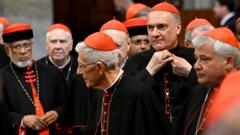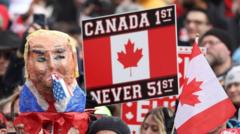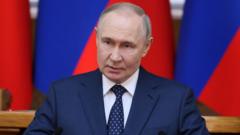As Canada grapples with existential challenges, millions of voters are making their way to the polls in a consequential election that will determine the nation’s leadership and its stance amidst external pressures led by President Donald Trump. The electoral race pits Prime Minister Mark Carney of the Liberal Party against Conservative leader Pierre Poilievre, both of whom have been affected by the unfolding impacts of Trump’s trade policies and the nation’s increasing economic woes.
Canada's Crucial Election: A Battle for Leadership Amidst Trump’s Shadow

Canada's Crucial Election: A Battle for Leadership Amidst Trump’s Shadow
Canadians head to the polls to choose their next leader, influenced by President Trump's trade tactics and economic challenges at home.
Polls indicate a competitive edge for Carney’s Liberals just weeks after he took on the role, reversing the Conservative’s strong lead earlier this year. Economic concerns, particularly a costly housing crisis and inflationary pressures on groceries and gas, have become focal points for Canadian voters. The housing market remains in dire straits; with escalating prices in urban areas like Toronto and Vancouver, many citizens are expressing desperation over affordability.
Political dynamics shifted notably following Justin Trudeau’s resignation. Carney, leveraging his financial expertise, is advocating for the liberal response to Trump’s aggression, which includes taxation policies aimed at aiding first-time home buyers. Poilievre, in contrast, connects with constituents through a promise of a smaller government and a return to traditional economic policies.
Significantly, Trump’s influence is palpable even across the border, where he has made comments suggesting Canada could become the “51st state,” igniting criticism on both sides. During the campaign, voters have raised concerns regarding U.S.-Canadian relations amidst tariffs affecting key industries such as automobile manufacturing.
In the busy lead-up to Election Day, social media has played a crucial role in shaping public perception, with hyper-partisan platforms gaining traction partly due to a news blockade affecting major media on social sites. As Canadians enter polling stations, nearly half a million have already participated in early voting, indicating a robust electoral engagement.
Underscoring the necessity for a coalition in this plurality system, observers argue that the results from Ontario and Québec, where a lion's share of electoral seats reside, will likely dictate the election outcome. It is here, in defining battlegrounds, that both parties are focusing their efforts, presenting their visions for a Canada navigating through tensions and seeking security in an era of uncertainty.
As Canadians cast their votes, the next prime minister must contend with not only domestic challenges but also the loud echoes of Trump’s policies that have profoundly affected public sentiment and electoral strategies.
The Canadian public is at a crossroads, and today may define the future roadmap in addressing both its economic challenges and international relations.
Political dynamics shifted notably following Justin Trudeau’s resignation. Carney, leveraging his financial expertise, is advocating for the liberal response to Trump’s aggression, which includes taxation policies aimed at aiding first-time home buyers. Poilievre, in contrast, connects with constituents through a promise of a smaller government and a return to traditional economic policies.
Significantly, Trump’s influence is palpable even across the border, where he has made comments suggesting Canada could become the “51st state,” igniting criticism on both sides. During the campaign, voters have raised concerns regarding U.S.-Canadian relations amidst tariffs affecting key industries such as automobile manufacturing.
In the busy lead-up to Election Day, social media has played a crucial role in shaping public perception, with hyper-partisan platforms gaining traction partly due to a news blockade affecting major media on social sites. As Canadians enter polling stations, nearly half a million have already participated in early voting, indicating a robust electoral engagement.
Underscoring the necessity for a coalition in this plurality system, observers argue that the results from Ontario and Québec, where a lion's share of electoral seats reside, will likely dictate the election outcome. It is here, in defining battlegrounds, that both parties are focusing their efforts, presenting their visions for a Canada navigating through tensions and seeking security in an era of uncertainty.
As Canadians cast their votes, the next prime minister must contend with not only domestic challenges but also the loud echoes of Trump’s policies that have profoundly affected public sentiment and electoral strategies.
The Canadian public is at a crossroads, and today may define the future roadmap in addressing both its economic challenges and international relations.






















